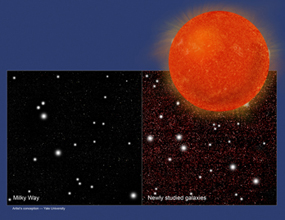Discovery Triples Number of Stars in the Universe

Astronomers detected the faint signature of small, dim red dwarf stars in nearby galaxies (right), and found they are much more numerous than in our own Milky Way (left). Image credit: Patrick Lynch/Yale University
Astronomers have discovered that small, dim stars known as red dwarfs are much more prolific than previously thought — so much so that the total number of stars in the universe is likely three times bigger than previously believed.
Because red dwarfs are relatively small and dim compared to stars like our Sun, astronomers hadn’t been able to detect them in galaxies other than our own Milky Way and its nearest neighbors before now. Therefore, they did not know how much of the total stellar population of the universe is made up of red dwarfs.
Now astronomers have used powerful instruments on the Keck Observatory in Hawaii to detect the faint signature of red dwarfs in eight massive, relatively nearby galaxies called elliptical galaxies, which are located between about 50 million and 300 million light years away. They discovered that the red dwarfs, which are only between 10% and 20% as massive as the Sun, were much more bountiful than expected. (more…)
